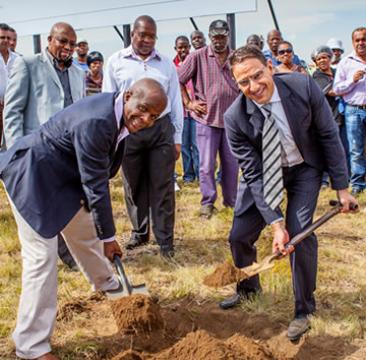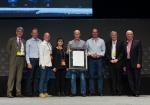More Shopping Centres to be built Despite Weak Economy
 Some of the newest developments inaugurated this year include the 25 000m² shopping centre in Mayfield developed by Investec. Mayor of Ekurhuleni, Mondli Gungubele seen with Darryl Mayers from Investec Property at the first sod turning ceremony.
Some of the newest developments inaugurated this year include the 25 000m² shopping centre in Mayfield developed by Investec. Mayor of Ekurhuleni, Mondli Gungubele seen with Darryl Mayers from Investec Property at the first sod turning ceremony.
Despite challenging economic conditions more shopping centres are expected to be built this year as retailers roll out new stores to increase their market share and commercial banks experience strong growth in loan demand from existing and new property clients.
Grant Rothman, head of finance at Nedbank Corporate Property Finance says loan demand from existing and new property clients is expected to grow this year, despite challenging economic conditions.
“We continue to support activity in the marketplace, and pay constant attention to the quality of the assets we originate” Rothman says.
Nedbank Corporate Property Finance posted a sterling set of results with 13.9% growth in headline earnings in the year to December, compared with the year before, thanks to its selective growth strategy.
Nedbank Corporate, which has the largest market share of the commercial property finance business in SA, approved and paid out new loans of R14 billion, and also paid out an additional R18 billion for existing facilities.
“This is a very pleasing result given the current market conditions and is, in part, the result of a considered and cautious strategy around origination when the market was more buoyant four years ago,” he says.
Despite weak economic growth the commercial property market is experiencing favourable decline in arrears, as well as the improvement in the levels of defaulted advances.
This has resulted in a year-on- year reduction in the credit loss ratio from 2011 to 2012. He attributes the improving arrears and expected downward trend in the credit loss ratio to efforts by Nedbank Corporate to assist distressed clients. “This will continue to remain a key focus area of the division, seeking to enhance operational efficiency and service to our clients, without added costs,” Rothman says.
Since the beginning of last year, there has been a wave of new shopping-centre development across the country, supported by retail expansion and backing from banks and creating intense competition among shopping centres.
In a normal year, one or maybe two major shopping centres break ground in SA, but last year and this year are proving to be extraordinary with several large developments planned.
SA Commercial Prop News noted some of the newest developments planned for completion this year and 2014 include:
- the 15,000m² Seshego Mall just outside Limpopo's capital Polokwane,
- 34 000m² KwaMnyandu Shopping Centre, in Umlazi KwaZulu-Natal,
- 30,000m² Moruleng Mall in the North West province,
- 25,000m² Mayfield Square in Daveyton Gauteng,
- 16 500m² in Olievenhoutbosch, 12500sqm in Ezakheni (Ladysmith),
- 14 500sqm in Madadeni/Osisweni(Newcastle),
- Emoyeni Mall, 25 000m² in Pienaar, east of Nelspruit,
- 12,000m² Tugela Ferry Shopping Centre in Masinga District of KwaZulu-Natal,
- 27,000m² Dihlabeng Mall in Bethlehem Free State,
- 20,000m² Kinako Mall in Port Elizabeth's iBhayi area Eastern Cape as well as the;
- 72,000m² Forest Hill City in Centurion Gauteng.
According to Spire Property Management at least 160 retail centres have been developed nationally in township and rural areas between 1962 and 2009, covering about 2-million square metres of retail space and generating about R34bn in sales, while having added about 54300 permanent jobs to the national economy since the 1980s.
Despite some developers having given up on shopping centre developments in the country citing municipalities’ inefficiencies and corruption, new developments worth billions of Rands are planned in the next three years.
Large shopping centres are likely to be built in Port Elizabeth, Midrand, Krugersdorp, Secunda, Cape Town and Pretoria West. But shopping centres are not only planned in urban and metropolitan areas, rural areas and small towns are also getting their fair share.
The main reasons for the development of new shopping centres appear to be a strong emerging middle class that is beginning to shop, and retailers wanting to capture this market.
But the new shopping centres are likely to cannibalise older shopping centres, which will need to do refurbishments and reposition themselves to stay in the game. And in rural town retailers are experiencing good trade as government’s social grants have increased spending.
According to Amanda Stops, CEO of South African Council of Shopping Centres (SACSC), new large shopping centre developments will be focused in South Africa's metropolitan areas as it makes sense considering the latest population statistics.
“For the next two years, new shopping centres bigger than 30,000sqm include several green-field developments of large regional shopping centres on the fringes of our metropolitan areas,” Stops says.
“Residential growth in their immediate vicinity will drive the sustainability of these centres.”
Infill shopping centre development, where there is already a large numbers of households in an area underserviced by retail, will also occur. “This capitalises on existing infrastructure and these centres should act as catalysts for other commercial activities,” says Stops.
Major metropolitan areas, such as Johannesburg, Cape Town, eThekweni and Tshwane, have the highest population growth figures by far. This impacts the needs for housing, job creation, schools, and general infrastructure, including retail centres.
What is propelling new shopping centres developments is that local authorities have made the land available, though in most instances, developers face rezoning challenges and delays.
Local developers can be thankful that local conditions are different from places such as the UK and Australia, where it is difficult to build a new shopping centre. That is because of council restrictions, largely driven by land scarcity.
But the only disadvantage locally is that most developers also face power-supply problems.
Some of the malls that opened last year include the R500m 23000m² Nicolway Bryanston Shopping Centre owned by the Rodrigues Group and developed by Flanagan & Gerard; the R500m 43000m² Middelburg Mall in Mpumalanga developed by Moolman Group and Flanagan & Gerard; and the 38000m² Newcastle Mall in KwaZulu-Natal developed by Zenprop for R400m.
Shopping centres planned are a 100000m² centre in Midrand’s Waterfall City by Atterbury Group, and the 75000m² Cradlestone Mall in Krugersdorp developed by Sasol and Retail Africa.
There is also a planned 40000m² Burgersfort Mall, bordering Limpopo and Mpumalanga, by Resilient Property Income Fund, and the Atlantic Mall in Cape Town, expected to be 78000m², to be developed by Flanagan & Gerard and Intaprop.
Other new developments include the 72000m² Forest Hill City Mall in Pretoria West, which is expected to cost about R1,45bn to build, and the 88000m² Bay West City in Port Elizabeth at a cost R1,75bn, to be developed by the Billion Group. The Billion Group is also planning a big shopping centre in Mthatha in the Eastern Cape.
There is also the planned 45000m² Secunda Mall in Mpumalanga, which is expected to cost R700m. It will be owned by Sasol Pension Fund and Resilient.
Ms Stops says shopping centre development plans underway for 2013 to 2014 will create some 600,000sqm more retail space in shopping centres over 30,000sqm alone. However, this growth rate of 3.8% is subdued compared to recent years.
Total retail space in shopping centres above 30,000sqm increased from 1,8 million m2 in 1993 to over 7,8 million m2 in 2012 – a growth rate of 7.8% a year. Most of these larger shopping centres - around 72% - are in South Africa’s five metropolitan areas. The rest are mainly in cities, with only 3% in rural areas.
“Several shopping centres are built in rural areas, but most are smaller. However, some should expand above 30,000 m2 this year,” says Stops. “Many suitable rural areas have already gained retail development in recent years, but there are still growth opportunities here.”
However, in a competitive market and subdued economy, every shopping centre development must guarantee its financial feasibility before breaking ground.
“Prudent shopping centre development needs sufficient population and income in a local trade area,” explains Stops. “The market must be sustainable with adequate supporting households and enough disposable income. With this in mind, the demand for retail space will keep on increasing in Gauteng and Western Cape, while this growth will be much lower in other provinces.”
Established shopping centres will remain under pressure to stay competitive in the prevailing economic environment.
“Beside our shopping centre owners and managers developing innovative strategies for tenant mix, advancing service levels and investing in an attractive shopping environment, there are other important factors needed to support a healthy shopping centre industry and economy,” says Stops.
She notes the key to future growth in South Africa is stability and strong GDP growth where new job opportunities can be created.
There is also a planned 40000m² Burgersfort Mall, bordering Limpopo and Mpumalanga, by Resilient Property Income Fund, and the Atlantic Mall in Cape Town, expected to be 78000m², to be developed by Flanagan & Gerard and Intaprop.
Also taking place is the redevelopment of The Mall of Rosebank by Hyprop. The mall will be extended from about 37000m² to 62000m², and the cost of extensions and refurbishment is expected to be about R920m.
But there are plenty of opportunities and some risks, chief among them high operating costs, and manufacturers and retailers feeling the effects of higher property taxes and electricity tariffs.

















